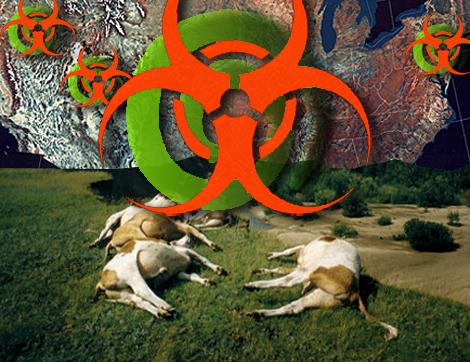
By Frank Whalen
Despite funding and safety concerns, plans are still in the works to replace the aging Plum Island Animal Disease Center, which houses the deadliest viruses, bacteria and other pathogens in the world, with the new National Bio-and Agro-Defense Facility (NBAF). With construction already under way, some are wondering why a project with such deadly implications is being housed in the middle of the country’s “Beef Belt,” in Manhattan, Kansas.
According to a recent article from the Journal of the American Veterinary Medical Association, the 500,000-square-foot facility will “cost between $525 million and $575 million.” There will also be funding allocated to “include public outreach to ensure that all stakeholders surrounding the facility understand the value of the proposed work and the safeguards in place that ensure the work will be done safely.”


The aging Plum Island facility (dating from 1954) operates “biosafety level three” laboratories, which refers to safety standards set by the Centers for Disease Control and Prevention. On the other hand, the NBAF will have laboratories at biosafety level 4, the highest level, which allows for expanded research of significantly more virulent diseases.
The Department of Homeland Security (DHS), which is responsible for security at the labs, states that the NBAF will cover the full gamut of diseases, researching “high-consequence biological threats involving human, zoonotic (i.e., transmitted from animals to humans) and foreign animal diseases.”
In 2010, the Government Accountability Office tasked a committee to assess DHS safety and security plans. The results were not encouraging.
The committee found “that the probability of an infection resulting from a laboratory release of FMDv [the highly contagious and often fatal foot-and-mouth virus, which attacks livestock] from the NBAF in Manhattan, Kansas approaches 70% over 50 years, with an economic impact of $9-$50 billion.” Officials also stated they were “seriously concerned about the current designs which omit redundant HEPA [high efficiency particulate air] filters for reasons of practicality and cost savings. Any facility-design compromises due to budgetary limitations will need to be viewed as inconsistent with the mission of providing a state-of-the-art facility with minimal risk of pathogen escape from containment.”



Over the years, Plum Island has had its share of controversy. Brian Dunning, host of the science news website “Skeptoid,” wrote: “Twice in 2004, foot-and-mouth disease was accidentally released inside the biocontainment area” and “in 1978, animals kept in outdoor pens on Plum Island were found to have been infected with foot-and-mouth disease.” He admits, “[Plum Island’s] research included the development of biological weapons prior to 1969.”
In the late 1990s, Dr. Patricia Doyle reported: “Plum Island had been featured in many news reports over the years for safety violations. In 1994, dead lab birds had been found outside in open air in the corridor of the exotic disease lab. Plum Island officially denied research with birds, but I have confirmation from a Plum Island worker that they did, indeed, research birds as vectors of disease.” She added, “Birds have been an efficient vector in the spread cycle of West Nile virus,” which suggests that the water barrier around the island was a false safety net.
——
Frank Whalen has been a radio talk show host for the past 17 years, and worked as a consultant for Maxim magazine. For more news and views from Frank, see www.frankwhalenlive.com.

